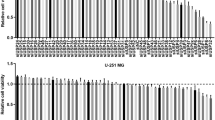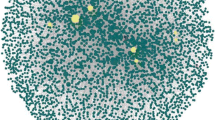Abstract
The ubiquitin proteasome pathway is conserved from yeast to mammals and is necessary for the targeted degradation of most short-lived proteins in eukaryotic cells. Its protein substrates include cell cycle regulatory proteins and proteins that are not properly folded in the endoplasmic reticulum. Owing to the ubiquity of its protein substrates, ubiquitination regulates a variety of cellular activities, including cell proliferation, apoptosis, autophagy, endocytosis, DNA damage repair, and immune response. With new genomic data continuously being obtained, ubiquitination through genomic data analysis will be an effective method. We obtained 83 overlapping genes from four glioma databases, which differed from ubiquitin ligase Nrdp1 expression, including 36 downregulated and 47 upregulated genes. The KEGG pathways, molecular functions, cellular components, and biological processes potentially associated with Nrdp1 were obtained using GSEA and Cytoscape. In human gliomas, differences in the expression of Nrdp1 were identified between nontumor brain tissue and different glioma tissues, but no difference in expression was found between low‑grade glioma (LGG) and anaplastic glioma (AG). In survival analysis, we found no significant association between Nrdp1 expression level and patient prognosis.




Similar content being viewed by others
References
Bleeker, F. E., Molenaar, R. J., & Leenstra, S. (2012). Recent advances in the molecular understanding of glioblastoma. Journal of Neuro-Oncology, 108(1), 11–27.
Ostrom, Q. T., Bauchet, L., Davis, F. G., Deltour, I., Fisher, J. L., Langer, C. E., Pekmezci, M., Schwartzbaum, J. A., Turner, M. C., & Walsh, K. M. (2014). The epidemiology of glioma in adults: a "state of the science" review. Neuro-Oncology, 16(7), 896–913.
Stupp, R., Roila, F., & Group, E. G. W. (2009). Malignant glioma: ESMO clinical recommendations for diagnosis, treatment and follow-up. Annals of Oncology, 20(Suppl 4), 126–128.
Diamonti, A. J., Guy, P. M., Ivanof, C., Wong, K., Sweeney, C., & Carraway, K. L. (2002). An RBCC protein implicated in maintenance of steady-state neuregulin receptor levels. Proceedings of the National Academy of Sciences of the United States of America, 99(5), 2866–2871.
Qiu, X. B., & Goldberg, A. L. (2002). Nrdp1/FLRF is a ubiquitin ligase promoting ubiquitination and degradation of the epidermal growth factor receptor family member, ErbB3. Proceedings of the National Academy of Sciences of the United States of America, 99(23), 14843–14848.
Yu, F., & Zhou, J. (2008). Parkin is ubiquitinated by Nrdp1 and abrogates Nrdp1-induced oxidative stress. Neuroscience Letters, 440(1), 4–8.
Zhong, L., Tan, Y., Zhou, A., Yu, Q., & Zhou, J. (2005). RING finger ubiquitin-protein isopeptide ligase Nrdp1/FLRF regulates parkin stability and activity. The Journal of Biological Chemistry, 280(10), 9425–9430.
Qiu, X. B., Markant, S. L., Yuan, J., & Goldberg, A. L. (2004). Nrdp1-mediated degradation of the gigantic IAP, BRUCE, is a novel pathway for triggering apoptosis. The EMBO Journal, 23(4), 800–810.
Wang, C., Chen, T., Zhang, J., Yang, M., Li, N., Xu, X., & Cao, X. (2009). The E3 ubiquitin ligase Nrdp1 ‘preferentially' promotes TLR-mediated production of type I interferon. Nature Immunology, 10(7), 744–752.
Chen, S. J., Lin, J. H., Yao, X. D., Peng, B., Xu, Y. F., Liu, M., & Zheng, J. H. (2016). Nrdp1-mediated degradation of BRUCE decreases cell viability and induces apoptosis in human 786-O renal cell carcinoma cells. Experimental and Therapeutic Medicine, 12(2), 597–602.
Wu, Y., Wang, L., Bao, H., Zou, S., Fu, C., Gong, H., Gao, Y., Tang, Y., Yu, R., & Shi, H. (2016). Nrdp1S, short variant of Nrdp1, inhibits human glioma progression by increasing Nrdp1-mediated ErbB3 ubiquitination and degradation. Journal of Cellular and Molecular Medicine, 20(3), 422–429.
Shi, H., Gong, H., Cao, K., Zou, S., Zhu, B., Bao, H., Wu, Y., Gao, Y., Tang, Y., & Yu, R. (2015). Nrdp1-mediated ErbB3 degradation inhibits glioma cell migration and invasion by reducing cytoplasmic localization of p27(Kip1). Journal of Neuro-Oncology, 124(3), 357–364.
Cao, K., Gong, H., Qiu, Z., Wen, Q., Zhang, B., Tang, T., Zhou, X., Cao, T., Wang, B., Shi, H., & Wang, R. (2016). Hepatitis B virus X protein reduces the stability of Nrdp1 to up-regulate ErbB3 in hepatocellular carcinoma cells. Tumor Biology, 37(8), 10375–10382.
Yen, L., Cao, Z., Wu, X., Ingalla, E. R., Baron, C., Young, L. J., Gregg, J. P., Cardiff, R. D., Borowsky, A. D., Sweeney, C., & Carraway, K. L. (2006). Loss of Nrdp1 enhances ErbB2/ErbB3-dependent breast tumor cell growth. Cancer Research, 66(23), 11279–11286.
Shi, H., Du, J., Wang, L., Zheng, B., Gong, H., Wu, Y., Tang, Y., Gao, Y., & Yu, R. (2014). Lower expression of Nrdp1 in human glioma contributes tumor progression by reducing apoptosis. IUBMB Life, 66(10), 704–710.
Shao, X., Lu, Q., Wang, G., Huang, W., Yang, L., & Chen, Z. (2018). Reduced expression of Nrdp1 predicts a poor prognosis in human hepatocellular carcinoma. OncoTargets and Therapy, 11, 4955–4963.
Jiao, S., Liu, W., Wu, M., Peng, C., Tang, H., & Xie, X. (2015). Nrdp1 expression to predict clinical outcome and efficacy of adjuvant anthracyclines-based chemotherapy in breast cancer: a retrospective study. Cancer Biomarkers, 15(2), 115–123.
Gao, Y., Han, D., Sun, L., Huang, Q., Gai, G., Wu, Z., Meng, W., & Chen, X. (2018). PPARalpha regulates the proliferation of human glioma cells through miR-214 and E2F2. BioMed Research International, 2018, 3842753.
Tran, V. M., Wade, A., McKinney, A., Chen, K., Lindberg, O. R., Engler, J. R., Persson, A. I., & Phillips, J. J. (2019). Significance and prognostic value of the coagulation profile in patients with glioblastoma: implications for personalized therapy. World Neurosurgery, 121, e621–e629.
Tran, V. M., Wade, A., McKinney, A., Chen, K., Lindberg, O. R., Engler, J. R., Persson, A. I., & Phillips, J. J. (2017). Heparan sulfate glycosaminoglycans in glioblastoma promote tumor invasion. Molecular Cancer Research, 15(11), 1623–1633.
Printsev, I., Yen, L., Sweeney, C., & Carraway, K. L. (2014). Oligomerization of the Nrdp1 E3 ubiquitin ligase is necessary for efficient autoubiquitination but not ErbB3 ubiquitination. The Journal of Biological Chemistry, 289(12), 8570–8578.
Chen, L., Siddiqui, S., Bose, S., Mooso, B., Asuncion, A., Bedolla, R. G., Vinall, R., Tepper, C. G., Gandour-Edwards, R., & Shi, X. (2010). Nrdp1-mediated regulation of ErbB3 expression by the androgen receptor in androgen-dependent but not castrate-resistant prostate cancer cells. Cancer Research, 70(14), 5994–6003.
Ingalla, E. Q., Miller, J. K., Wald, J. H., Workman, H. C., Kaur, R. P., Yen, L., Fry, W. H., Borowsky, A. D., Young, L. J., Sweeney, C., & Carraway, K. L. (2010). Post-transcriptional mechanisms contribute to the suppression of the ErbB3 negative regulator protein Nrdp1 in mammary tumors. The Journal of Biological Chemistry, 285(37), 28691–28697.
Funding
The present study was supported by the Foundation of Jiangsu Provincial Health Department (grant no. YG201514), Xuzhou Medical University (grant no. 2018KJ09).
Author information
Authors and Affiliations
Corresponding author
Ethics declarations
Conflict of Interest
The authors declare that they have no conflict of interest.
Additional information
Publisher’s note Springer Nature remains neutral with regard to jurisdictional claims in published maps and institutional affiliations.
Rights and permissions
About this article
Cite this article
Liu, Y., Jin, M., Gao, Y. et al. Prediction of Ubiquitin Ligase Nrdp1-Associated Proteins in Glioma Database. Cell Biochem Biophys 78, 301–308 (2020). https://doi.org/10.1007/s12013-020-00926-1
Received:
Accepted:
Published:
Issue Date:
DOI: https://doi.org/10.1007/s12013-020-00926-1




